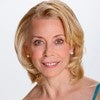Description
About This Video
Transcript
Read Full Transcript
Welcome to Pilates Anytime. I'm Elizabeth Larkam and I'm so privileged, so happy to be back with you on Pilates Anytime. This is my seventh year, which is only an indication, proof, that Pilates makes you younger. We're filming in early January on 2018 and we'd like to extend our heartfelt well wishes to everyone who was affected by the Southern California and the Thomas Fires. Now to the class at hand, you have a chair, preferably a chair with split pedal, the handles are in at the low setting.
You'll be using a ring but not immediately, so just put the ring aside so you can catch it later and just before the end of the class, we'll use a long box. So here you are with your lighter spring attached. I have the lighter spring on the lowest setting. That may be too light for you, so feel free to move it up a little bit higher. You'll be kneeling in front of the chair with your knee even with the middle of the pedal or between the two pedals, quite close to the floor apron of the chair.
Then your outside leg will be forward. Take your hand on the forward on pedal and your hand on the chair handle. You could dorsiflex. Tuck your toes under of your back leg. As you inhale, push the pedal down and turn upwards towards the ceiling.
Do two of these and then aim your heel wide to the side of your supporting knee. Move your leg back further on the diagonal in hip extension and external rotation and then take your foot right behind you. Rocking into your heel one more of these as you collect from pubic bone up underneath your rib cage. Now change your front hand to the back pedal. Change your top hand to the back handle and resume only it will be a different experience because the vectors of your arms, your hands, are pulling you in the direction of more extension with your rotation.
Take your leg on the diagonal. Pressing through your back heel and then finally pressing through the sole of your toes and your metatarsals. One more here because it's a long distance from your lifted elbow to your back heel. Staying on this same side, bring the supporting leg forward. Take the forward pedal and the forward handle.
Now you're lunging towards the inside leg. Inhale to rotate. Three of these facing forward and change to your hand on the back pedal. Change your front leg to the back. The forward pedal in hip extension.
And the back pedal and the back handle also in hip extension. Now the other side. You might ask yourself, why are we doing these? It's my experience that the mobility and the organization of the thoracic area which we can achieve through side bending and rotation is really useful to help with the kneeling balances and rotation that we'll be doing soon. Your back toes are tucked under.
You're standing on the knee that's closest to the chair and the outside leg is forward approximately 90 degrees. Bring your hand to the front pedal, your hand to the front handle and here we go. As you inhale, you rotate. What's turning? Lower ribs, middle ribs, upper ribs, neck, head and eyes.
Take your heel wide to the side of your knee and rotate. Now your outside leg will stay in external rotation. And it goes back behind you into hip extension, ideally aligning your big toe with your hip joint. And if you, too, had an overhead camera, you would know whether you were truly aligned or not. Unfortunately, you'll be able to see whether I am not.
Take your hand on the back pedal. Inhale to rotate. And to the side, side lunges leaning away from the chair. And back behind you. Quite the distance from back heel to lifted elbow.
Change now the inside knee comes forward and you take the forward handle, three of these. Keeping this same leg position, you take the back handle. And then change legs. The front leg comes to the back. And the hands go finally to the back as well.
This particular exercise is so sobering because it points out the differences of range of motion and organization between sides, between what would be known as the lateral mile fascia continuities. So sobering is I think a word that's preferable to use rather than depressing because sobering, you go wow, look at that, I can't do that on this side. But at least I can try. Now, onward to the next event. You'll take the handles off.
For the next event, you'll do your pull up abs with different arm positions on the chair top. Have a heavy spring as you prefer it. I have a heavy spring on the top. Your (springing) spring adjusting. The leg will be in external rotation and have the heels of your hands over the corners of the chair.
Work in the direction of spine extension. So you have lumbar, thoracic and a little bit of cervical extension. Inhale for the pelvis to come up, two and three and, and four. Change with both hands close to you. One and two and three and four.
One hand goes on the far pedal, the far corner so that you have a diagonal relationship between your hands. And then change diagonals. Bring the front hand to the same side as the back. So now you have a little bit of thoracic side bending, intending to keep your pelvis, your sacrum, straight ahead, and pelvis and sacrum straight ahead, while you have thoracic side bending. After leading up with the sitting bones all this time, now you'll have a bit of a posterior pelvic tilt and spine flexion.
With the pads of your fingers touching, looking back towards your abdominals. Now we go to kneeling on the chair top, pushing the pedal down with one foot. Kneeling on the chair top now, bring your supporting leg to the middle of the chair top and your other leg on the chair pedal. Make sure that you have a firm purchase on this pedal such that your first three toes and your heel are on the top of the pedal when it's pressed down. Both hands on the chair top over the corners of the pedals, both sides of your waist long.
Initially, keep your heel, firmly, the whole sole of your foot in contact with the pedal as you rotate, turning your pelvis and your lumbar spine towards the supporting leg and towards the leg coming up, turning your pelvis around the femur head. Now you change that motion such that you add your plantar flexion and dorsiflexion. Continue with the rotation of the pelvis around the supporting leg, taking care to keep the pedal waist long, not hip hiking. Continue this rhythm and this motion of rotation of the pelvis and spine and of your leg, and lift one arm off. Keeping your torso level and steady, your thoracic area and your shoulder girdle.
When you take the other arm off, you'll need to shift your central axis slightly towards the chair pedal in order to have enough strength, enough force to push the pedal down. Now you are well prepared for the rotations. Turning towards the chair pedal, and then bending your elbow, turning away from the chair pedal. Inhale to turn towards the pedal as it goes down, exhale to turn away. Reverse, stay turned away as you push the pedal down, and then come towards.
Turn away and, and then come towards. Change arms as you push the pedal down you turn away and you turn towards. Turn away and towards. Reverse that movement relationship and turn away as it comes up, turn towards. And away.
Change now to the new side. Climb aboard so that your knee is at the middle of the chair top and carefully place your first three toes and your heel on the pedal. Organize your shoulder girdle, collarbones wide, back of your neck long. Turn your pelvis and your lumbar spine so your navel and your sacrum face the side of the supporting leg and the side of the moving leg. All the while aiming both sitting bones back behind you so that the pedal side of your waist doesn't shorten.
Add the motion of your ankle and of your knee. Continue, she reminded herself, with the pelvis rotating. Turning the pelvis towards the ocean and then away from the ocean. Turning towards the supporting thigh. Now if all's going reasonably well, take one arm off.
Shifting your central axis towards the pedals, take the other arm off. Stand your ground on the thigh that's on top of the chair. And then turning towards the pedal as it goes down, turning away, turning towards, and away. Stay here so you can turn away as you push the pedal down and towards and away. And towards.
Change arms, turn away from the pedal and towards it. Turn towards and away and towards and away. Time now for the next arm and abdominal intermission. So we'll turn the chair so you can have a better view of the next variation. For this rendition of pull ups on the chair, you'll stand with your side to the chair.
My right side is to the chair. The inside leg goes onto the back pedal, the inside foot on the back pedal, and the outside foot on the forward pedal. We'll start with both hands to the forward corners of the chair top. Intending to bring your pelvis in the direction of an anterior pelvic tilt, have the idea that your lumbar and thoracic area can be in the direction of extension, shift your weight towards the chair and hover four times. Land the pedals.
Change your hand to the corner behind. Now your chest bone and gaze will be over the free corner that's forward, upend. Pulling back in this case with the left side of the pelvis, the left hip. Change your left hand to the free corner so that now both hands are at the back of the chair and your chest bone and gaze at the middle of the chair top. The right hand moves back one corner.
Now your gaze is over the back free corner. And the front hand moves to that back corner. So here you are, well prepared for thoracic side bending. Lessen that to a degree and use the two corners that you haven't used yet. And bend both elbows, pads of your fingers and thumbs touching.
Now your gaze is back in the direction of your lower abdominals. So that you have a good view of the second side, we'll just turn the chair around. Here you are for the second side of the ab pull ups on the chair. Use your inside foot to the back pedal, and the outside foot to the forward pedal. This position of your legs, with the outside leg forward, encourages your pelvis and your lumbar spine to turn in the direction of the chair.
Both hands are on the forward corners and as you shift your weight towards the chair and a little bit forward, you will be able to hover your pelvis and the pedals. Land the pedals, change the back hand to the back corner. Shift your focus, your attention, your gaze, your chest bone, to the forward corner that's free. Cover up that corner. Shift your gaze, your focus, your attention to the center of the chair top.
The back hand moves one corner back. Turn towards the free back corner. And bring the front hand to cover that back corner so that now you'll have quite a bit of weight, in this case on the left hand, because the left side of the waist, the thoracic area is flexed to the left. Time now to kneel on the chair top with the ring. So reach for the ring and we'll flip the chair around.
Kneeling on the center of the chair top, your foot will be on the back pedal and with your ring, place the ring at the bottom of your chest bone, right at your xiphoid process so it's on bone, not on belly. Okay, staying steady and upright, push the pedal down. And you'll hike your hip up and dehike. Hike up and dehike. So initially your knee doesn't bend, your heel doesn't lift.
This would be lumbar side bending just in case anyone wanted to give it a really dry name. You could call it tail wagging also and I'm sure you could call it something else if you'd like. Now, level your pelvis and bend your knee and push the pedal down with the sole of your toes, the ball of your foot. So unlike the previous side bending tail wagging, now you endeavor to keep both sides of your waist long and articulate through your hip, ankle and foot. If all's going reasonably well, continue this articulation and turn away from the pedal and then turn towards the pedal.
Inhale most likely to turn away, exhale to turn towards. Two more of these. Turn away and turn towards. And turn away. Change up the movement relationship.
Turn towards the pedal as it pushes down, turn away from. Inhale and exhale. Most likely your pelvis will be fairly steady and the rotation is from the thoracic, the cervical area, as well. You've been standing on this knee for quite some time. Let's change sides now.
Here you are on the new side with your supporting knee at the center of the chair top in line with the space between the pedals. You have a firm purchase with your first three toes and your heel in contact with the pedal. And the ring is on bone, not belly, at the bottom of your rib cage. Now move your pelvis in order to push the pedal down and then move your pelvis in order to bring the pedal up. So here you are in lumbar side bending.
Keeping your sagittal access steady. Add to this the knee flexion and plantar flexion. Now I left out a variation on the first side. It's possible to have your hip hike lumbar side bending and then dehike. But sometimes just because something is possible doesn't mean it's preferable and in my opinion that possibility is not so preferable, so just keep your pelvis level and go through the knee flexion and ankle motion.
Add to this as you push the pedal down, you turn your thoracic area away from it and then turn towards it. Turn away when the pedal comes up, aim your sitting bone down in the direction of the pedal, or else you too will be jacked up into lumbar side bending. Oh no, not that. Turn towards the pedal as you push it down, keep your sitting bone aiming in the direction of your heel. Twice more with this particular variation.
Time now for more pull ups with your side to the chair, this time with the new leg, the different leg, in back. For this third version of pull ups on the chair, you'll stand with your side to the chair and now it's the outside leg that's on the back pedal and the inside leg is on the front pedal. This orientation of your legs is encouraging the pelvis to turn away from the chair, which means that your pelvis will be rotating one direction and your thoracic spine the other. This is the most demanding, and that's why we're doing it third. Have both hands forward to the corners of the chair and aim your sitting bones up and back behind you.
Shift your central axis towards the chair and hover. Four of these. Land the pedals for your transition. The front hand moves one corner to the back and now you focus over the free corner at the front. Move the front hand to cover that corner and now your focus with your chest bone and your gaze is at the center of the chair between your hands.
The back hand moves one corner closer to you. Now your focus is on the back corner of the chair. And the front hand moves to cover that back corner and you can focus anywhere you'd like because this is difficult enough. Undo your side bending. Hands on the corners again.
The corners closer to you. Now bring your forearms on to the chair top, the pads of your fingers and thumbs touching and your gaze back towards your mid thighs. Easy on the dismount now, and the new side awaits. One thing we know for sure is that the new side will always be different. Here you are on the new side with the outside leg on the back pedal and the inside foot on the front pedal.
Encouraging your pelvis to turn away from the chair, your hands cover the corners of the chair. You shift towards the chair and lead up and back with your sitting bones. Chest bone lift a little bit in the direction of thoracic extension. Move your hand to the back corner and you and your focus over the front corner that's closer to your front hand. Change your front hand to cover that back corner and shift towards the chair.
The back hand moves one corner. You change your focus to reflect increased thoracic side bending. And the front corner covers the back corner. Now your pelvis is turning away from the chair and your thoracic spine turning towards the hands at the back. Undo that exceptional, extreme thoracic side bending.
And come on to your forearms, pads of your fingers and thumbs touching. Easy on the dismount. Come off the front pedal, come off the back pedal. And now prepare to kneel on the chair top with the ring high above your head. When you're kneeling on the chair pedal with the ring, you have options of how to hold the ring.
You could have your thumbs on the inside of the ring handles in which case pulling outwards with your thumbs and downwards with the little finger side of your hand and your shoulder blade. That will help to organize your scapula in abduction with, and depression. You could also have your palms on the inside of the ring, palms facing outward, so that you pull outward on the ring handles and drive your shoulders down. We'll take both of those options. So start with your thumbs on the inside of the ring.
Push the pedal down and take the ring high above your head. Pulling outwards with your thumbs, downwards with the little finger side of your hand and your shoulder blade. As you press the ring up and back behind your head, behind the back top of your head, you have the lumbar side bending, pushing the pedal down with your sitting bone. It's your sitting bone that drives your heel down. Now as you push the pedal down, you turn away from it and as the pedal comes up, you turn towards it.
Pushing the pedal down with lumbar side bending as you rotate away from it, and then coming up. Reverse that. Push the pedal down and then hike it up as you turn away. Inhale to push it down, exhale to come away. Turn your palms the other way now, palms pressing outward, shoulders driving down and lumbar side bending.
Turning away, turning towards, turning away, turning towards, turning towards, turning away, turning towards, turning away, she said somewhat tentatively. Let's do this much now on the other side with the lumbar side bending and tail wagging. Here you are standing on the new side, or standing on your knee on the new side. Take the ring high above your head, high above the back of your head, with your thumbs pulling outward and the little finger side of your hand and shoulder blade drawing downward. As you press the ring up, drive the lumbar spine into side bending, lengthening the pedal side of your waist and then hiking it up.
Continue this motion and accompanying it with the thoracic rotation. As your sitting bone impresses the pedal down, you turn away. As the pedal comes up, you turn towards. Reverse that movement relationship, pushing down with the pedal, and turning away as it comes up. Usually inhale to push down, exhale to come up.
That same variations can be done with your palms pressing outwards, your shoulders drawing downwards. Turning away, turning towards, turning away, turning towards, turning towards, turning away, turning towards, turning away. The question is if my eyebrows go higher, will the pedal go lower? Sometimes. Time for an intermission now, intermission from keeling.
So you can focus even more on thoracic extension. This will help in the next ring overhead variation. Here you are seated on the chair top with your hips near the back of the chair top and your hands over the ends of the pedals. As you inhale, you'll arch into thoracic extension and take your gaze in the direction of your hand on the chair pedal. As you inhale, it's extension and rotation.
You could aim your eyes in the direction to which you're turning and I'd suggest aiming your tongue in the direction of the part of the pelvis that doesn't twist. So here, turning towards the left side, aim your tongue down to the right to keep the right side of your pelvis steady and so it won't follow to your left hand. Inhale, eyes right, tongue left. Exhale, center. Inhale, eyes left, tongue right.
But now you practice it, 'cause I have to talk and consequently, my tongue has to go a lot of different places. Now, spine flexion, curl into posterior pelvic tilt and spine flexion, and sustain spine flexion as you push the pedals down. Collarbones wide, reflected by your hands, your fingers being wide as well. Now arc into thoracic and lumbar extension as if your pubic bone were tipping towards the chair top. Tongue up, eyes up, and sustain thoracic extension.
Now you alternate. Spine flexion, undulating into spine extension. Spine flexion, spine extension. What's implied is internal rotation of the humerus and external rotation. Internal rotation and external reverse.
External rotation into spine extension, internal rotation deflection, external rotation and internal rotation. Twice more. And finally you alternate those two. Flexion, extension, extension and flexion. Flexion, extension, aiming your inner knees towards each other.
Last two. And last one. Now we'll finish up with the high kneeling, the ring above your head with rotation. Kneeling on the chair top, thumbs on the inside of the ring, take the ring high above near the back of your head and keeping your pelvis fairly steady and level, push the pedal down from your hip, knee, ankle and foot. So now you won't lumbar side bend.
You won't tail wag. And as you push the pedal down, you'll turn away from it and you'll turn towards it. Inhale pulling outwards with your thumbs, exhale drawing downwards with your shoulder blades. Change the movement relationship. Turn towards the pedal as you push it down.
Turning your right lung in front of you to the left and your left lung behind you to the right. Change so your palms are on the inside as you push the pedal down, pull outwards with your hands and downwards with your shoulders. Lifting your upper chest bone, your upper sternum, up and forward as you rotate. And turn towards the pedal as you push it down, endeavoring to keep the pedal side of your waist long. Change now to the new side.
Climb aboard the chair. Knee lined up with the center of the pedal. First three toes and heel getting a firm purchase. Take the ring high above your head, thumbs outward. Get accustomed to this side articulating at your hip, knee, ankle and foot.
Carry the ring up and back, high above the back top of your head. And keeping the pedal side of your waist long, turn away as you push the pedal down, and turn towards (springing) spring adjustment, sorry. Turn away and towards. Inhale to rotate, exhale to return. Change the movement relationship turning towards the pedal as it goes down, turning away.
And finally change your palms pressing outwards. Turning away, turning towards, turning away. Inhale as if to come closer to the ceiling each time the pedal goes towards the floor. Inhale to get a little longer, exhale to keep that length. Twice more.
Thank you so much for joining us. I really appreciate you taking an interest in this class. All the best. See you next time. Bye bye.
Comments
Fantastic class. Today I start to practice ....

You need to be a subscriber to post a comment.
Please Log In or Create an Account to start your free trial.



























